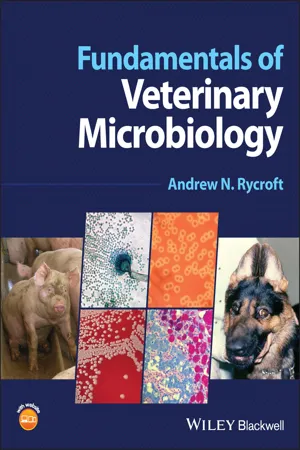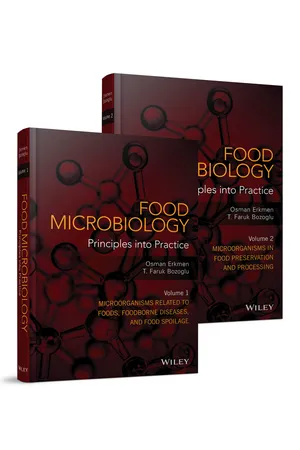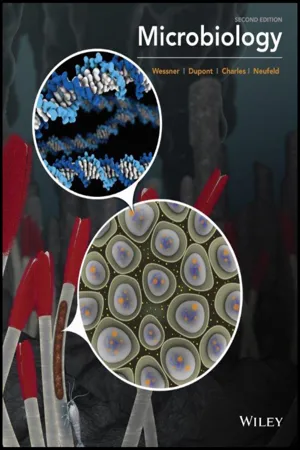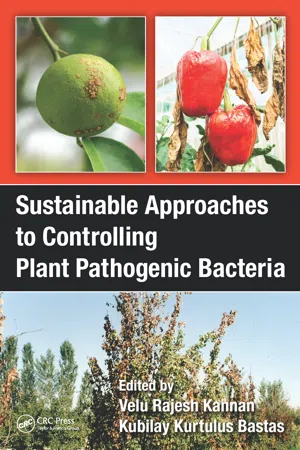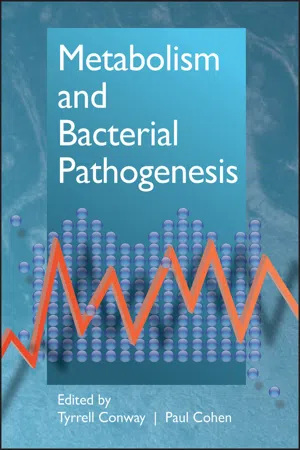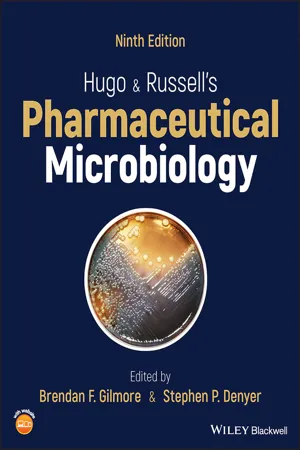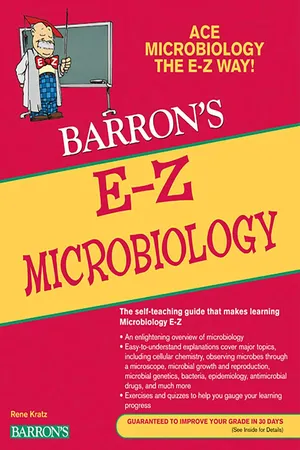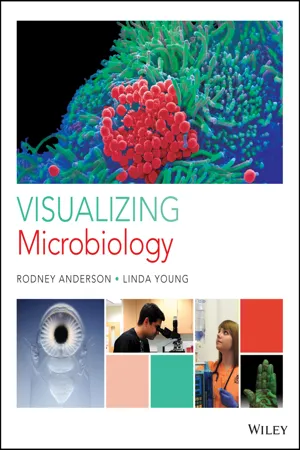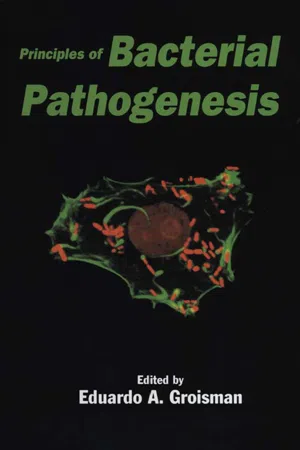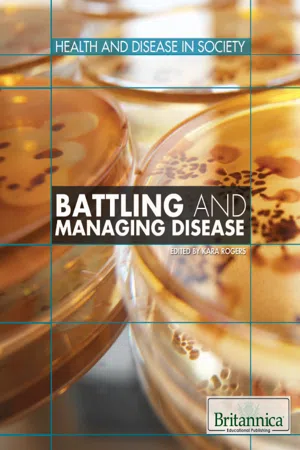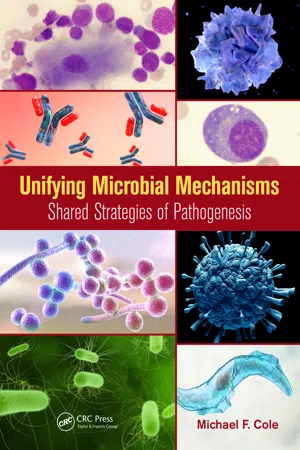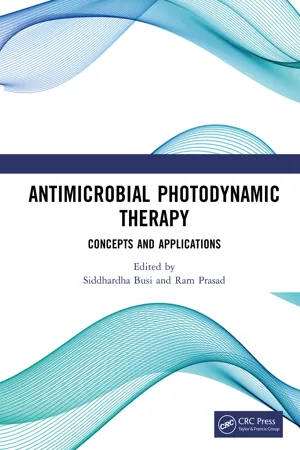Biological Sciences
Pathogenic Bacteria
Pathogenic bacteria are microorganisms that can cause disease in humans, animals, and plants. They have the ability to invade and multiply within the host, leading to infections and illness. Pathogenic bacteria can produce toxins or trigger immune responses that contribute to the development of various diseases.
Written by Perlego with AI-assistance
Related key terms
12 Key excerpts on "Pathogenic Bacteria"
- eBook - ePub
- Andrew N. Rycroft(Author)
- 2023(Publication Date)
- Wiley-Blackwell(Publisher)
Brucella and several others. The number of bacteria recognised as having this capability has steadily increased recently and a surprising proportion that were thought only to have an extracellular existence have since been shown to be capable of transient intracellular behaviour.Pathogenicity
Pathogenicity is the ability of an infectious agent to cause disease. It is a property conferred by characteristics and attributes of the bacteria. Virulence, a term often used interchangeably with pathogenicity, is the measure or degree of that pathogenic ability.Invasion is the process of microorganisms entering the tissues or host cells and spreading in the body.An opportunistic pathogen is an agent capable of causing disease only when the host's resistance to infection is impaired or the natural bacteria changed or removed. While it is easier to think of bacteria as pathogens or commensals, in reality there is a very blurred overlap of the two. Pathogens can live as saprophytes in the environment or as commensals on the body. Bacteria that we consider commensals can sometimes turn pathogenic when circumstances allow. While very many bacteria are never recorded (with meaningful evidence) as causing disease in animals, occasional case reports of species that were thought of as harmless do appear. This has been highlighted by the immunosuppressive conditions that have become commonplace in human and animal medicine (Salyers and Whitt 1994 ).To be pathogenic, an organism must usually be able to fulfil all the five steps below.- Gain access to the host.
- Survive and multiply.
- Acquire nutrients.
- Resist or avoid the host defences.
- Damage host tissues.
Access to the Host
Bacteria may enter the host from an external source (exogenous) or be already present on or in the body (endogenous). Organisms enter the host animal using different routes: injured skin or mucous membrane, the urinary tract, reproductive tract, gastrointestinal tract, respiratory route, etc. - eBook - ePub
Food Microbiology
Principles into Practice
- Osman Erkmen, T. Faruk Bozoglu(Authors)
- 2016(Publication Date)
- Wiley(Publisher)
Chapter 7 Bacterial Pathogenicity and Microbial Toxins7.1 Introduction
A pathogen is a microorganism capable of causing diseases in human beings and animals. Pathogenicity is the ability to cause disease in a host organism. Microorganisms express their pathogenicity by means of their virulence characteristics. Determinants of virulence of a pathogen are genetic, biochemical, and structural characteristics that enable it to produce disease in a host. The relationship between a host and a pathogen depends on the virulence ability of the pathogen and the relative degree of resistance or susceptibility of the host. Virulence provides a quantitative measure of the pathogenicity or the ability of causing disease. Virulence factors affect the pathogenicity of microorganisms. Some of the virulence factors are adherence, which is the ability of pathogen to colonize on the mucosal membrane by using pili (fimbriae); invasion factors, which are surface components that allow the bacterium to invade host cells; capsules, which are surrounded polysaccharides that protect them from opsonization and phagocytosis; endotoxins, which can cause fever, changes in blood pressure, inflammation, lethal shock, and many other toxic events; and exotoxins, which are proteins and enzymes produced and/or secreted from Pathogenic Bacteria.Pathogenic Bacteria cause invasiveness and toxigenicity. Invasiveness is the ability of pathogen to invade tissues. It enhances colonization (adherence and initial multiplication), increases production of extracellular substances that facilitate invasion, provides ability to bypass, and enables to overcome host defense mechanisms. Invasion involves the ability of the bacterium to grow in the host, either in an extracellular environment or in an intracellular environment. Invasive bacteria injure the host tissue through the production of extracellular enzymes.Toxigenesis is the ability of pathogen to produce toxins. Bacterial pathogens that damage the host through the action of toxins are called noninvasive (toxigenic); they have limited capacity to spread in the host, but bacterial toxins often act distanced from the site of infection. Bacterial toxins are transported across the bacterial membranes through cotranslational and posttranslational mechanisms to reach their targets. Transport systems mostly use active transport, requiring energy. - eBook - ePub
- Dave Wessner, Christine Dupont, Trevor Charles, Josh Neufeld(Authors)
- 2016(Publication Date)
- Wiley(Publisher)
damaging tissue. This distinguishes them from non-Pathogenic Bacteria that may also be living on or within the body, but do not damage tissue to obtain nutrients. Pathogens are not evil entities that set out to purposefully kill their host, although that may sometimes be the outcome; the host is simply a nutrient source and a place to live, and pathogens have adapted to exploit this habitat. It is really no different from the way humans exploit the resources of the planet. This also results in damage, and although we do not do this for the purpose of destroying the environment, harm may be an outcome.Bacterial pathogens can produce a spectrum of diseases that range from damage due to production of a single toxin, to diseases produced largely because of a robust but relatively ineffective host immune response. In many cases, the damage is caused by both the pathogen and the host response to the pathogen. Most bacterial pathogens follow a common scheme that leads to the establishment of infection. The pathogen must gain access and often attach to host tissue, avoid host defenses, and get nutrients needed to multiply. These requirements are some of the key aspects of bacterial pathogenesis that we will investigate. As we shall see, many of the products produced by pathogens that allow them to carry out these processes are encoded on specific genetic elements that can be transferred between strains and even other species. This genetic mobility is a principal feature in pathogen evolution.Our investigation of bacterial pathogenesis will focus on answering the following questions:- What are some common features of bacterial pathogens? (21.1 )
- How do bacterial toxins act on host cells? (21.2 )
- How do bacterial pathogens cause disease? (21.3 )
- How do some bacteria become pathogens? (21.4 )
21.1 Bacterial virulence factorsWhat are some common features of bacterial pathogens?We previously came across the term “virulence factor” (see Section 18.2 ). A virulence factor is a product made by a pathogen that enhances its ability to cause disease. As you might imagine, the range of virulence factors that Pathogenic Bacteria produce is vast ( Table 21.1 ) - V. Rajesh Kannan, Kubilay Kurtulus Bastas(Authors)
- 2015(Publication Date)
- CRC Press(Publisher)
Chapter 1Plant Pathogenic Bacteria
An Overview Velu Rajesh Kannan, Kubilay Kurtulus Bastas, and Robert AntonyAbstract Phytopathology is an interdisciplinary biological science that comprises botany, microbiology, crop science, soil science, ecology, genetics, biochemistry, molecular biology, and physiology. In general, plant diseases are caused by living organisms (called pathogens) and by nonliving agents. Plant diseases and changes in existing pathogens remain a constant threat to our forests, food and fiber crops, and landscape plants. However, many economically important pathosystems are largely unexplored and biologically relevant life stages of even familiar systems remain poorly understood. Development of new and innovative ways to control plant diseases is a constant challenge for plant pathologists. The modern mindset in this context favors a broad perspective that considers multifaceted approaches to plant Pathogenic Bacterial control. This chapter, which discusses impact of plant Pathogenic Bacterial pathogenesis on scientific and economic levels, introduces the various mechanisms, measuring tools, and controlling strategies that will be elaborated in the following chapters.Keywords: plant pathogen, phytopathology, plant bacterial disease, pathosystem, disease-controlling strategy1.1 Introduction
The immense diversity of plant pathogens, which include viruses, bacteria, fungi, nematodes, and insects, approximates 7100 species. Among these, roughly 150 are bacterial species that cause diseases to plants. The major ways that bacterial pathogens cause plant diseases are by obtaining nutrients one or more host plants for their own growth; using specific mechanisms to secrete proteins and other molecules to locations on, in, and near their hosts; and by exploiting these proteins and other molecules modulate or avoid plant defense circuitry to enable parasitic colonization (Chisholm et al., 2006; Davis et al., 2008). Bacterial plant diseases are most frequent and severe in tropical and subtropical places, where warm and humid conditions are ideal for bacterial growth. Indeed, consistent annual crop losses are recorded in all countries.- eBook - ePub
- Tyrrell Conway, Paul S. Cohen(Authors)
- 2015(Publication Date)
- ASM Press(Publisher)
Defining the threshold where subtle injury becomes pathogenesis is an uncertain endeavor: many individuals harbor subclinical inflammation of various organs with no frank manifestations and risk for adverse outcome only demonstrable at the population level (9, 10). There is clearly variation in the intrinsic virulence of bacteria on humans. Some bacteria rarely encounter a mammalian host without causing overt disease. At the other end of the spectrum, some rarely cause disease except in the most debilitated hosts. Use of the terms virulent pathogen and opportunistic pathogen would appropriately describe these scenarios. Some pathogens elicit clinical syndromes that promote the spread of the microorganism through the host community, presumably a direct effect of natural selection to increase the reproductive rate of the organism, i.e., the number of secondary cases occurring for each primary case (11) (reproduced in Equation 1). In fact, all of the variables in the reproductive number equation are acted upon by natural selection. Thus, a pathogen that is benefited by causing disease in a host population will forge a productive balance between transmissibility and virulence that will both promote its transmission today and assure a sufficient supply of susceptible hosts for transmission tomorrow. (This perspective is nowhere better articulated than in Zinsser’s classic work Rats, Lice and History [recently discussed in Weissman (2005)]. These observations hold for pathogens whose biological niches entail engendering disease in a host or host population. The strange case of tuberculosis comes in mind, in which the microorganism must cause symptomatic disease (cough) in order to be transmitted, but its long-term persistence in the community is favored by a long-term latent state with recrudescence of transmissibility once additional susceptibles are available - eBook - ePub
- Brendan F. Gilmore, Stephen P. Denyer(Authors)
- 2023(Publication Date)
- Wiley-Blackwell(Publisher)
The ability of bacteria and fungi to establish infections of plants, animals and humans varies considerably. Some are rarely, if ever, isolated from infected tissues, while opportunist pathogens such as Pseudomonas aeruginosa and Staphylococcus epidermidis can establish themselves most commonly in compromised individuals. Only a few species of bacteria may be regarded as obligate pathogens, for which animals or plants are the only reservoirs for their existence (e.g., Neisseria gonorrhoeae, Mycobacterium tuberculosis and Treponema pallidum). Viruses (see Chapter 5), on the other hand, must parasitise host cells to replicate and are therefore inevitably associated with disease. Even among the viruses and obligate bacterial pathogens, the degree of virulence varies, in that some (particularly the bacteria) can potentially coexist with the host without causing overt disease (e.g., Staphylococcus aureus), while others will always cause some detriment to the host (e.g., rabies virus). Organisms such as these invariably produce their effects, directly or indirectly, by actively growing on or in the host tissues. Other groups of microorganisms may cause disease through ingestion of substances (toxins) produced during microbial growth on foods (e.g., Clostridium botulinum, botulism; Bacillus cereus, vomiting). In this case, the organisms themselves do not have to proliferate in the host for the effects of the toxin to be manifested. Animals and plants constantly interact with bacteria present within their environment. For an infection to develop, such microorganisms must remain associated with host tissues and increase their numbers more rapidly than they can be either eliminated or killed - eBook - ePub
- Rene Kratz(Author)
- 2011(Publication Date)
- Barrons Educational Services(Publisher)
20Pathogenicity ofMicroorganisms WHAT YOU WILL LEARNThis chapter takes a look at the various tools and tricks pathogens use in order to colonize the body and get past your defenses. As you study this chapter, you will: • examine how pathogens enter the body; • discover the importance of attachment; • learn how pathogens evade defenses like complement and phagocytosis; • explore how pathogens damage host tissues with toxins.SECTIONS IN THIS CHAPTER• Ability to Invade Tissues• Evasion of Host Defenses• Damage to the HostThe human body has amazing defenses against invasion by microorganisms. Most microbes we encounter are prevented from establishing an infection by our innate immunity (Chapter 18 ). Those that do establish an infection are usually defeated by our adaptive immunity (Chapter 19 ). So why is it that we get sick at all? How do some microbes manage to get around our defenses? Why does their presence in our bodies cause disease?The ability of a microorganism to cause disease is its pathogenicity . A more familiar term might be virulence , which refers to the degree of pathogenicity. For example, an organism that very easily causes disease would be considered highly virulent. Microorganisms that are highly virulent have the ability to colonize the host easily and disrupt the host physiology. Any molecules that a microorganism makes and that help them to cause disease are called virulence factors . In other words, virulence factors are like the tool kit of a pathogen. What makes one pathogen different from another is what they have in their tool kit.REMEMBERA virulence factor is any molecule that helps a pathogen cause disease.The ability of a pathogen to cause disease depends on three main issues. First, the pathogen must be able to invade the host. Second, it must be able to evade the host defenses. And finally, it may produce enzymes or toxins that damage host tissues and contribute to the signs and symptoms of disease. The different strategies that pathogens use to invade the human body are truly amazing, and understanding the details of these mechanisms can help us figure out new ways to prevent disease. - eBook - ePub
- Rodney P. Anderson, Linda Young(Authors)
- 2016(Publication Date)
- Wiley(Publisher)
13 Microbial PathogenesisINFECTION AND DISEASE
S imple infection by a pathogen does not necessarily mean that disease will follow. Additional factors such as health status and environmental conditions are also involved. At times, several factors may combine with devastating consequences. For example, cholera can still cause large epidemics in areas where natural disasters or wars disrupt safe water supplies. After the devastating earthquake in Haiti in January 2010, the subsequent cholera outbreak spread to approximately 500,000 people, causing about 8000 deaths. The disease has still not been contained.This chapter presents the key features of pathogenesis that all microbes must follow to cause disease.Vibrio cholerae, the pathogen that causes cholera, growing in the digestive tract. If untreated, cholera kills about half of those affected.Juergen Berger/Science Source ImagesA young boy and his sister being treated for cholera in a clinic run by Doctors Without Borders, Port-au-Prince, Haiti.Julie Dermansky/Science Source ImagesCHAPTER OUTLINE
13.1Entering and Adhering to the Host• Microbial Reservoirs• Portals of Entry and Exit• Adhering to Host Cells13.2Transmission of Microbes• Modes of Transmission■ Case Study: The Cholera Epidemic in Goma, Zaire• Horizontal and Vertical Transmission13.3Bypassing Host Defenses• Evading Immune Attack• Altering Pathogen Antigens• Damaging the Host Immune System13.4Damaging Host Tissues• Direct Damage• Enzymes• Endotoxins• Exotoxins■ Clinical Application: Toxoid-based Vaccines• Immunopathy■ The Microbiologist’s Toolbox: Analysis of Hemolysis on Blood Agar13.5Factors Influencing Disease Outcomes• Host Factors■ What a Microbiologist Sees: Stress and Infection• Microbial FactorsCHAPTER PLANNER
□ Study the picture and read the opening story.□ Scan the Learning Objectives in each section:- p. 368 □ p. 372 □ p. 376 □ p. 381 □ p. 389 □
- eBook - ePub
- Eduardo A. Groisman(Author)
- 2001(Publication Date)
- Academic Press(Publisher)
CHAPTER 1Evolution of Bacterial Pathogens
HOWARD OCHMANI. Introduction II. The Genetic Basis of Virulence III. Identification of Sequences Involved in Bacterial Pathogenesis IV. Recovery of Genes Contributing to Virulence V. The Population Genetics of Pathogens VI. Studying Bacterial Population GeneticsA. Multilocus Enzyme Electrophoresis B. DNA Sequencing C. Multilocus Sequence TypingVII. The Organization of Genetic Diversity in Pathogenic Microorganisms VIII. Population Genetics of Representative Bacterial PathogensIX. Conclusions ReferencesA. BordetellaB. BorreliaC. Escherichia coli and ShigellaD. HaemophilusE. HelicobacterF. ListeriaG. MycobacteriumH. NeisseriaI. SalmonellaJ. StaphylococcusK. StreptococcusL. VibrioI. Introduction
In what ways do pathogenic microorganisms differ from nonpathogenic forms? For an organism to be considered a pathogen, it must, during some phase of its life-cycle, advance disease and alter the health or behavior of another organism, that is, its host. Every organism can serve as a host for pathogens, and pathogens come into contact with a very large number of species; however, most pathogenic microorganisms are virulent to relatively few, and often only one, host species, and infection may cause disease in only a limited segment of the host population. So despite the wide range of mechanisms deployed by pathogens to disable their hosts (and to promote their own replication and transmission), there is one common theme: virulence depends upon the susceptibility of a host. Therefore, the identification of pathogens, the differences between pathogenic and nonpathogenic microorganisms, and the specific factors required for virulence must each be defined with regard to its relevance to the host.This chapter addresses two general issues about the evolution of microbial pathogenesis. First, we consider the differences between the genomes of pathogenic and nonPathogenic Bacteria, the specific types of genes that contribute to the virulence phenotype, and the evolutionary history of these sequences in the genome of pathogens. Next, we discuss the molecular population genetics of microbial pathogens and the factors that govern the organization of genetic diversity within these populations. Because the origins and genetic bases of virulence influence the population structure of pathogens, these topics are interconnected and broadly relevant to the emergence, outbreak, control, and prevention of the diseases caused by microbial pathogens. - eBook - ePub
- Britannica Educational Publishing, Kara Rogers(Authors)
- 2010(Publication Date)
- Britannica Educational Publishing(Publisher)
Biotic agents include life-forms that range in size from the smallest virus, measuring approximately 20 nm (0.0000008 inch) in diameter, to tapeworms that achieve lengths of 10 metres (33 feet). These agents are commonly grouped as viruses, rickettsiae, bacteria, fungi, and parasites. The disease that these organisms cause is only incidental to their struggle for survival. Most of these agents do not require a human host for their life cycles. Many survive readily in soil, water, or lower animal species and are harmless to humans. Other living organisms, which require the temperature range of endothermic (warm-blooded) animals, may flourish on the skin or in the secretions of fluids of the mouth or intestinal tract but do not invade tissue or cause disease under normal conditions. Thus there is a distinction to be made between infection and disease.INFECTIOUS AGENTSAll animals are infected with biotic agents. Those agents that do not cause disease are known as nonpathogenic, or commensal. Those that invade and cause disease are called pathogenic. Streptococcus viridans bacteria, for example, are found in the throats of more than 90 percent of healthy persons. In this area they are not considered pathogenic. The same organism cultured from the bloodstream, however, is highly pathogenic and usually indicates the presence of the disease subacute bacterial endocarditis (chronic bacterial invasion of the valves of the heart). In order for such nonpathogenic agents to achieve pathogenicity, they obviously must overcome the defenses of the host. Most biotic agents require a portal of entry through the intact skin or mucosal linings of the body. They must be present in sufficient number to escape the phagocytes. They must be capable of surviving the inflammatory and immune response. Ultimately, to induce disease, they must have sufficient virulence and invasiveness to cause significant tissue injury.INVASIVENESS AND VIRULENCEInvasiveness is the capability of penetrating and spreading throughout tissues. Remarkably, little is known of the factors that condition it. In a few instances enzymes produced by biotic agents have been identified that are capable of breaking down the integrity of the supporting tissues of the body, thereby preparing a pathway for the spread of the organism. - eBook - ePub
Unifying Microbial Mechanisms
Shared Strategies of Pathogenesis
- Michael F. Cole(Author)
- 2019(Publication Date)
- Garland Science(Publisher)
Chapter 1: Introduction to PathogenesisINTRODUCTION
The aim of this text, is to examine and discuss common themes in microbial pathogenesis. Despite the class of pathogen – whether virus, bacterium, fungus or parasite – they all cause tissue injury and evade the host immune system in much the same ways and attack the same targets. Therefore, it seems only sensible to discuss pathogenic mechanisms in the context of all of these classes of pathogens. With rare exception, texts on pathogenesis have focused on a single class of pathogen, such as bacteria, without conveying any sense that the pathogenic mechanisms described can just as easily be applied to any other class of pathogen. Pathogenics is at the interface of microbiology and immunology because it considers the properties of a microorganism that harm the host and the innate and acquired host defence mechanisms that can neutralise them. The relationship between the pathogen and host is dynamic and reflects thrust and counter thrust. The fulcrum of this interaction can be moved to benefit either combatant by, for example, enhancing or compromising the host immune system or by the acquisition of new genes or loss of existing genes by the microorganism. We will return to this concept later. Because one cannot consider the microbe in the absence of the host, most texts of microbial pathogenesis feel obliged to devote a considerable amount of the text to basic immunology and basic microbiology as a prelude to the consideration of the mechanisms of pathogenesis of microbes. However, there is a plethora of excellent immunology and microbiology texts, both concise and comprehensive, that are superior to the coverage of these disciplines in pathogenesis texts. It is reasonable to say that students should be competent in immunology and microbiology before embarking on a course in microbial pathogenesis. For these reasons, basic microbiology and immunology are not covered in this book beyond that essential to understand particular pathogenic mechanisms. - eBook - ePub
Antimicrobial Photodynamic Therapy
Concepts and Applications
- Siddhardha Busi, Ram Prasad, Busi Siddhardha, Ram Prasad(Authors)
- 2023(Publication Date)
- CRC Press(Publisher)
Various mycobacterial cell surface ligands, such as HSP70, 19kDa lipoarabinomannan (LAM), phosphatidylinositol mannoside (PIM) and lipoprotein. These are recognised by specialised pattern recognition receptors (PRRs) and host cell phagocytise receptors (Dorhoi et al., 2011). The pathogen’s ability to survive, however, is aided by some receptors’ absorption. Streptococcus, another encapsulated bacterium, is responsible for certain extremely harmful invasive diseases, such as septicaemia and meningitis as they contain capsular substance, which is a virulence agent and contains sialic acid (Jacques et al., 1990). 1.7 General Characteristics of Acquired/Adaptive and Innate Immunity The environment in which humans and other mammals live is highly populated by both pathogenic and non-Pathogenic Bacteria, and contains a wide range of poisonous or allergic compounds that pose a threat to normal homeostasis. The host must be able to tolerate and keep in check the community of microbes in order to ensure healthy tissue and organ function. This community contains both obligatory pathogens and helpful commensal organisms. Pathogenic Bacteria have a wide range of ways by which they reproduce, disseminate, and endanger the stability of host functions. The immune system must prevent reactions that cause excessive damage to self-tissues or those that could eliminate helpful, commensal microorganisms, while simultaneously destroying pathogenic microbes and poisonous or allergenic proteins. A wide variety of poisonous compounds and Pathogenic Bacteria can challenge the host in our environment. These pathogens can employ a wide range of pathogenic methods to attack the host. It follows that the immune system employs a wide range of intricate defence systems to manage and typically get rid of these pathogens and poisons
Index pages curate the most relevant extracts from our library of academic textbooks. They’ve been created using an in-house natural language model (NLM), each adding context and meaning to key research topics.
